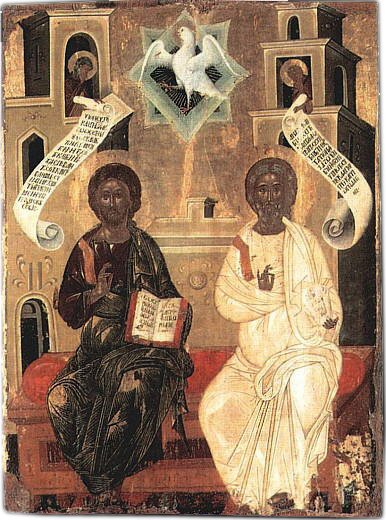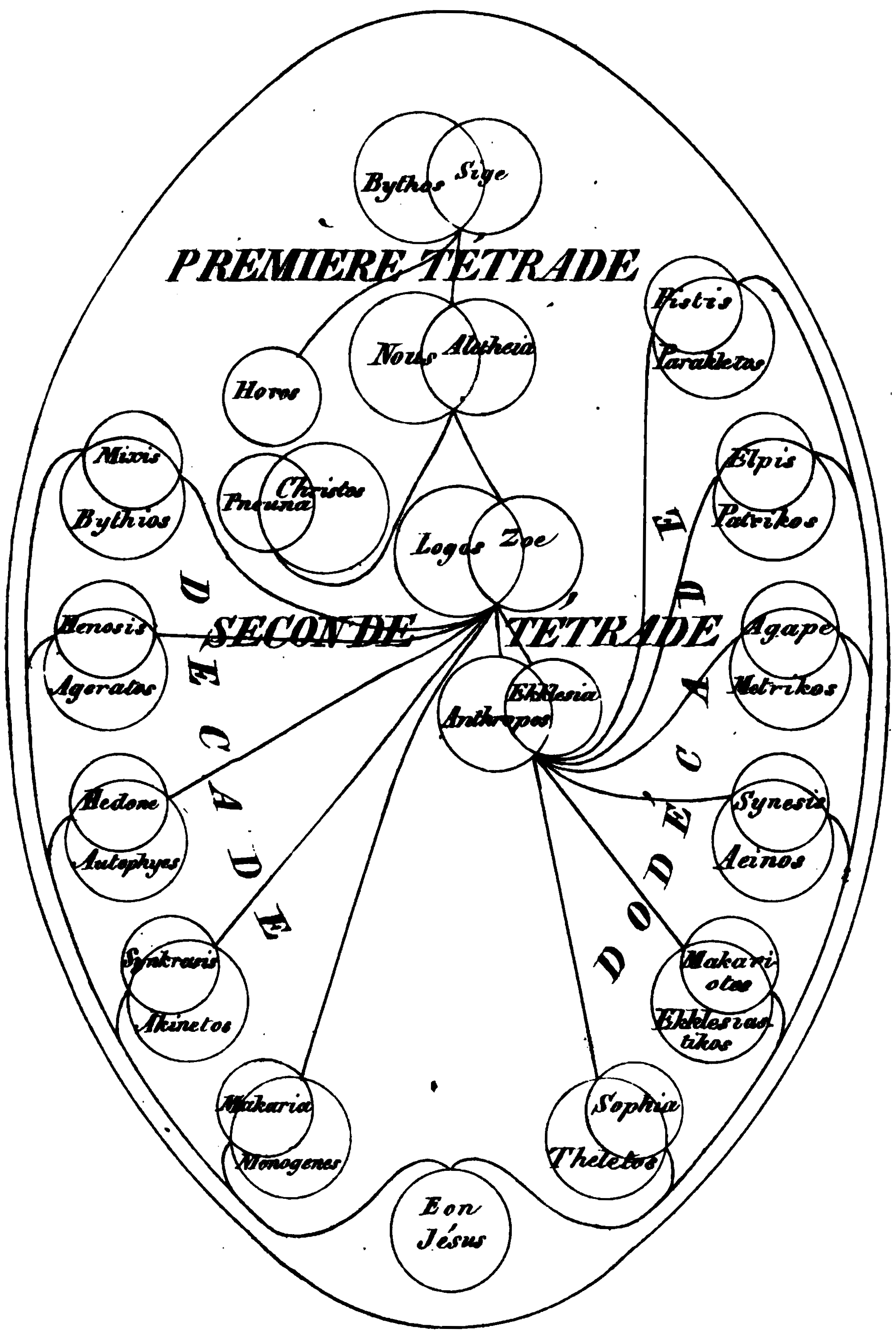|
Kalyptos
In Sethian Gnosticism, Kalyptos ("the Hidden One") is one of the three emanations of Barbelo (along with Protophanes and Autogenes according to ''Zostrianos''). Kalyptos is mentioned in Nag Hammadi texts such as ''Zostrianos'', ''The Three Steles of Seth'', ''Allogenes the Stranger'', and ''Marsanes''. See also *Aeon (Gnosticism) *Hypostasis (philosophy and religion) Hypostasis (Greek: ὑπόστασις, ''hypóstasis'') is the underlying state or underlying substance and is the fundamental reality that supports all else. In Neoplatonism the hypostasis of the soul, the intellect (''nous'') and "the one" was ... References Gnostic deities {{Gnosticism-stub ... [...More Info...] [...Related Items...] OR: [Wikipedia] [Google] [Baidu] |
Zostrianos
Zostrianos is a 3rd-century Sethian Gnostic text from the New Testament apocrypha. The main surviving copies come from the Nag Hammadi library, but it is heavily damaged.John D. Turner of the University of Nebraska writes concerning its date: "... one may date Allogenes around 200 C.E., with Zostrianos coming a bit later around 225 C.E. (Porphyry certainly recognized it as a spurious and recent work)." Porphyry's biography of Plotinus mentions ''Zostrianos''. The ''Enneads'' of Plotinus also criticize many Gnostic ideas that are given in ''Zostrianos''. Overview Like Marsanes and Allogenes, the text concerns a vision received by a man named Zostrianos and explains and enumerates, in great detail, the emanations that the Gnostics said are produced by God (the true, highest God as opposed to the demiurge), in the Gnostics' esoteric cosmology. Similarly to other gnostic literature, Zostrianos says, "Flee from the madness and the bondage of femaleness and choose for yourselves the ... [...More Info...] [...Related Items...] OR: [Wikipedia] [Google] [Baidu] |
Barbelo
Barbēlō (Greek: Βαρβηλώ)Iren., Epiph., Philast., ''Pist. Soph''., Hier.; -ρώ Epiph. as an alternative, 92 A, and similarly the Epitome, p. 354 Dind.; -λ, Epit. ''l. c. bis;'' -λώθ Theodoret. refers to the first emanation of God in several forms of Gnostic cosmogony. Barbēlō is often depicted as a supreme female principle, the single passive antecedent of creation in its manifoldness. This figure is also variously referred to as 'Mother-Father' (hinting at her apparent androgyny), 'First Human Being', 'The Triple Androgynous Name', or 'Eternal Aeon'. So prominent was her place amongst some Gnostics that some schools were designated as ''Barbeliotae'', Barbēlō worshippers or Barbēlō gnostics. The nature of Barbēlō Nag Hammadi Library In the ''Apocryphon of John'', a tractate in the Nag Hammadi Library containing the most extensive recounting of the Sethian creation myth, the Barbēlō is described as "the first power, the glory, Barbēlō, the perfect g ... [...More Info...] [...Related Items...] OR: [Wikipedia] [Google] [Baidu] |
Protophanes
In Sethian Gnosticism, Protophanes ("the First-Appearing One") is one of the three emanations of Barbelo (along with Kalyptos and Autogenes according to ''Zostrianos''). Protophanes is mentioned in Nag Hammadi texts such as ''Zostrianos'', ''The Three Steles of Seth'', Allogenes the Stranger'', and ''Marsanes''. See also *Aeon (Gnosticism) In many Gnostic systems, various emanations of God are known by such names as One, Monad, ''Aion teleos'' (αἰών τέλεος "The Broadest Aeon"), Bythos (, "depth" or "profundity"), ''Proarkhe'' ("before the beginning", ), ''Arkhe'' ("the ... References Gnostic deities {{Gnosticism-stub ... [...More Info...] [...Related Items...] OR: [Wikipedia] [Google] [Baidu] |
Autogenes
In Sethian Gnosticism, Autogenes (Meaning "Self-Born One" in Greek) is an emanation or son of Barbelo (along with Kalyptos and Protophanes according to ''Zostrianos''). Autogenes is mentioned in Nag Hammadi texts such as ''Zostrianos'', ''The Three Steles of Seth'', ''Allogenes the Stranger'', and ''Marsanes''. Autogenes in Gnosticism is roughly parallel to the Platonic soul. See also *Aeon (Gnosticism) *Plato's theory of soul Plato's theory of soul, which was inspired by the teachings of Socrates, considered the psyche ( ψυχή) to be the essence of a person, being that which decides how people behave. Plato considered this essence to be an incorporeal, eternal occu ... References Gnostic deities {{Gnosticism-stub ... [...More Info...] [...Related Items...] OR: [Wikipedia] [Google] [Baidu] |
Marsanes
Marsanes is a Sethian Gnostic text from the New Testament apocrypha. The only surviving copy comes from the Nag Hammadi library, albeit with four pages missing, and several lines damaged beyond recovery, including the first ten of the fifth page. Scholars speculate that the text was originally written by a Syrian in Greek during the third century. Overview Like Zostrianos, and Allogenes, the text describes a very elaborate esoteric cosmogony of successive emanations from an original God, as revealed by Marsanes, who is recognized as a Gnostic prophet. Within the text there are indications that the Sethians had developed ideas of monism, an idea comparable to Heracleon's notion of universal perfection and permanence as expressed through the constancy of the total mass of things within it (that is, ''all'' matter in the universe may only change form, and may not be created or destroyed), and the later Stoic Stoic may refer to: * An adherent of Stoicism; one whose moral quality is as ... [...More Info...] [...Related Items...] OR: [Wikipedia] [Google] [Baidu] |
Hypostasis (philosophy And Religion)
Hypostasis (Greek: ὑπόστασις, ''hypóstasis'') is the underlying state or underlying substance and is the fundamental reality that supports all else. In Neoplatonism the hypostasis of the soul, the intellect (''nous'') and "the one" was addressed by Plotinus. In Christian theology, the Holy Trinity consists of three hypostases: Hypostasis of the Father, Hypostasis of the Son, and Hypostasis of the Holy Spirit. Ancient Greek philosophy Pseudo-Aristotle used hypostasis in the sense of material substance. Neoplatonists argue that beneath the surface phenomena that present themselves to our senses are three higher spiritual principles, or hypostases, each one more sublime than the preceding. For Plotinus, these are the Soul, the Intellect, and the One.''Neoplatonism (Ancient Philosophies)'' by Pauliina Remes (2008), University of California Press , pp. 48–52. Christian theology The term hypostasis has a particular significance in Christian theology, particularly in Ch ... [...More Info...] [...Related Items...] OR: [Wikipedia] [Google] [Baidu] |
Sethian Gnosticism
The Sethians were one of the main currents of Gnosticism during the 2nd and 3rd century CE, along with Valentinianism and Basilideanism. According to John D. Turner, it originated in the 2nd century CE as a fusion of two distinct Hellenistic Judaic philosophies and was influenced by Christianity and Middle Platonism. However, the exact origin of Sethianism is not properly understood. History Mentions The Sethians (Latin ''Sethoitae'') are first mentioned, alongside the Ophites, in the 2nd century, by Irenaeus (who was antagonistic towards gnosticism) and in Pseudo-Tertullian (Ch. 30). According to Frederik Wisse, all subsequent accounts appear to be largely dependent on Irenaeus. Hippolytus repeats information from Irenaeus. According to Epiphanius of Salamis (c. 375), Sethians were in his time found only in Egypt and Palestine, but fifty years earlier, they had been found as far away as Greater Armenia. Philaster's (4th century CE) ''Catalogue of Heresies'' places the Ophit ... [...More Info...] [...Related Items...] OR: [Wikipedia] [Google] [Baidu] |
Emanationism
Emanationism is an idea in the cosmology or cosmogony of certain religious or philosophical systems. Emanation, from the Latin ''emanare'' meaning "to flow from" or "to pour forth or out of", is the mode by which all things are derived from the first reality, or principle. All things are derived from the first reality or perfect God by steps of degradation to lesser degrees of the first reality or God, and at every step the emanating beings are less pure, less perfect, less divine. Emanationism is a transcendent principle from which everything is derived, and is opposed to both creationism (wherein the universe is created by a sentient God who is separate from creation) and materialism (which posits no underlying subjective and/or ontological nature behind phenomena being immanent). Origins Emanationism is a cosmological theory which asserts that all things "flow" from an underlying principle or reality, usually called the Absolute or Godhead. Any teachings which involve emanati ... [...More Info...] [...Related Items...] OR: [Wikipedia] [Google] [Baidu] |
Nag Hammadi Library
The Nag Hammadi library (also known as the " Chenoboskion Manuscripts" and the "Gnostic Gospels") is a collection of early Christian and Gnostic texts discovered near the Upper Egyptian town of Nag Hammadi in 1945. Thirteen leather-bound papyrus codices buried in a sealed jar were found by a local farmer named Muhammed al-Samman. The writings in these codices comprise 52 mostly Gnostic treatises, but they also include three works belonging to the ''Corpus Hermeticum'' and a partial translation/alteration of Plato's ''Republic''. In his introduction to ''The Nag Hammadi Library in English'', James Robinson suggests that these codices may have belonged to a nearby Pachomian monastery and were buried after Saint Athanasius condemned the use of non-canonical books in his Festal Letter of 367 A.D. The discovery of these texts significantly influenced modern scholarship's pursuit and knowledge of early Christianity and Gnosticism. The contents of the codices were written in the C ... [...More Info...] [...Related Items...] OR: [Wikipedia] [Google] [Baidu] |
Three Steles Of Seth
The Three Steles of Seth is a 3rd-century Sethian Gnostic text from the New Testament apocrypha. History The main surviving copies come from the Nag Hammadi library, and were translated and explained by Paul Claude, member of the Nag Hammadi Research Group of the Faculty of Theology and Religious Studies, Université Laval (Quebec). The text concerns a revelation to Dositheos about three steles (text written into specially created stones). Many scholars think that they are designed as liturgy. The text is thought to be from the Sethian sect of Gnostics (the sect that viewed the biblical Seth as their hero, who was reincarnated as Jesus). Their other texts include the Apocalypse of Adam, Apocryphon of John, the Trimorphic Protennoia, and the Coptic Gospel of the Egyptians. The text is thought to be a 3rd-century development of the Sethian Gnostics, as they became more separated from Christianity, and closer to Platonism. The Three Steles (or Tablets) of Seth are in essence, ... [...More Info...] [...Related Items...] OR: [Wikipedia] [Google] [Baidu] |
Allogenes The Stranger
Allogenes is a repertoire, or genre, of mystical Gnostic texts dating from the first half of the Third Century, CE. They concern Allogenes, "the Stranger" (or "foreigner"),Greek: (''allogenēs''), used in the Septuagint, meaning "rom adifferent family/nation" a half-human, half-divine capable of communicating with realms beyond the sense-perceptible world, into the unknowable. Sources and Dating The Coptic text of ''Allogenes'' (Allog), the first Allogenes source to be discovered in modern times, is the third item in Codex XI of the Nag Hammadi library (NHC XI,3), held on leaves 45-69. The tops of many leaves are missing, as is the entire opening to the work. ''The Temptation of Allogenes'' (Allogenes T), also in Coptic, is the fourth item in the Codex Tchacos, discovered in the 1970s but not made public until 2006. As this source also contains the text for the controversial Gospel of Judas, far more attention has been accorded to that work than to ''The Temptation of Allogenes' ... [...More Info...] [...Related Items...] OR: [Wikipedia] [Google] [Baidu] |
Aeon (Gnosticism)
In many Gnostic systems, various emanations of God are known by such names as One, Monad, ''Aion teleos'' (αἰών τέλεος "The Broadest Aeon"), Bythos (, "depth" or "profundity"), ''Proarkhe'' ("before the beginning", ), ''Arkhe'' ("the beginning", ), and Aeons. In different systems these emanations are differently named, classified, and described, but emanation theory is common to all forms of Gnosticism. In Basilidian Gnosis they are called sonships (υἱότητες ''huiotetes''; sing.: υἱότης ''huiotes''); according to Marcus, they are numbers and sounds; in Valentinianism they form male/female pairs called syzygies (Greek , from σύζυγοι ''syzygoi'', lit. "yokings together"). This source of all being is an Aeon, in which an inner being dwells, known as ''Ennoea'' ("thought, intent", Greek ), ''Charis'' ("grace", Greek ), or ''Sige'' ("silence", Greek ). The split perfect being conceives the second Aeon, ''Nous'' ("mind", Greek Νους), within its ... [...More Info...] [...Related Items...] OR: [Wikipedia] [Google] [Baidu] |


